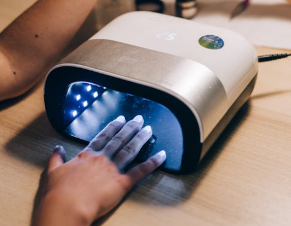Europe says this nail polish ingredient is too dangerous—so why are we still using it here?
By
Maan
- Replies 9
A beauty product found in salons worldwide has been pulled from shelves across Europe.
Officials ruled that a common ingredient in gel nail polish posed potential risks to human health.
But the chemical remains legal in countries like the UK and US—for now.
The European Union banned trimethylbenzoyl diphenylphosphine oxide, or TPO, in all cosmetics from 1 September.
The decision followed studies linking the chemical to long-term fertility issues.
Industry experts said the UK may implement a similar ban by the end of 2026.
TPO was a key ingredient in gel nail polish because it acted as a photoinitiator, helping polish harden under ultraviolet light.
It also contributed to long-lasting colour and shine, making gel manicures a favourite among customers.
However, scientists warned that the chemical could be toxic when absorbed into the body
Salons across the EU’s 27 member states—as well as Norway and other countries that mirror EU regulations—were told to stop using TPO-based gels and dispose of existing stock.
Manufacturers were instructed to reformulate their products without the banned ingredient.
The US has yet to adopt similar rules, though American businesses sourcing polish from Europe may feel the effects.
Francesca Rapolla, senior affairs manager at the Cosmetic, Toiletry and Perfumery Association, explained: ‘In the case of TPO, the industry did not and could not defend the continued use of this ingredient in nail products mainly because it could not demonstrate that there are no alternative ingredients to this one.’
Not all experts agreed with the decision, with some arguing that the evidence was not strong enough to justify the ban.
Doug Schoon, a consultant at Schoon Scientific, wrote: ‘If left uncorrected, this decision will once again impose unnecessary economic burdens, waste safe products, and undermine confidence in EU regulatory proportionality.’
Belgian retailer ASAP Nails and Beauty Supply echoed concerns, warning the ban would cause ‘major economic damage’ to small businesses despite ‘no human evidence of danger’.
The decision also reignited debate over other chemicals hidden in beauty products, with experts pointing to endocrine disruptors linked to diabetes, obesity, cancer and reproductive disorders.
Cases of endometriosis—where womb tissue grows outside the uterus—rose from 3.4 million in 1990 to 190 million globally today.
During gel manicures, experts explained, the chemicals entered the skin if UV lamps were not used properly or equipment was poorly maintained.
Phthalates, another controversial additive, were common in nail polish, perfumes and hair products.
These chemicals could disrupt hormones, increase breast cancer risk, and even cause developmental delays in babies exposed in the womb.
Professor Katie Burns, a fertility and toxicology expert at the University of Cincinnati, warned: ‘These are chemicals that will stay in the body for a long, long time, hidden in fatty tissue.
‘They impact the immune system, and in some women we believe this may trigger reproductive problems and endometriosis.’
It’s not just nail polish under the spotlight—questions are being raised about the safety and honesty of many products we use every day.
Even when labels promise purity or eco-friendly credentials, the truth behind those claims can be harder to pin down.
That’s why it’s worth looking at how advertising plays a role in shaping what we believe about the products we bring into our homes.
Read more: Social media ads are littered with ‘green’ claims. How are we supposed to know they’re true?

Beauty trends may come and go, but are the risks hidden in our everyday products worth the glossy finish?
Officials ruled that a common ingredient in gel nail polish posed potential risks to human health.
But the chemical remains legal in countries like the UK and US—for now.
The European Union banned trimethylbenzoyl diphenylphosphine oxide, or TPO, in all cosmetics from 1 September.
The decision followed studies linking the chemical to long-term fertility issues.
Industry experts said the UK may implement a similar ban by the end of 2026.
TPO was a key ingredient in gel nail polish because it acted as a photoinitiator, helping polish harden under ultraviolet light.
It also contributed to long-lasting colour and shine, making gel manicures a favourite among customers.
However, scientists warned that the chemical could be toxic when absorbed into the body
Salons across the EU’s 27 member states—as well as Norway and other countries that mirror EU regulations—were told to stop using TPO-based gels and dispose of existing stock.
Manufacturers were instructed to reformulate their products without the banned ingredient.
The US has yet to adopt similar rules, though American businesses sourcing polish from Europe may feel the effects.
Francesca Rapolla, senior affairs manager at the Cosmetic, Toiletry and Perfumery Association, explained: ‘In the case of TPO, the industry did not and could not defend the continued use of this ingredient in nail products mainly because it could not demonstrate that there are no alternative ingredients to this one.’
Not all experts agreed with the decision, with some arguing that the evidence was not strong enough to justify the ban.
Doug Schoon, a consultant at Schoon Scientific, wrote: ‘If left uncorrected, this decision will once again impose unnecessary economic burdens, waste safe products, and undermine confidence in EU regulatory proportionality.’
Belgian retailer ASAP Nails and Beauty Supply echoed concerns, warning the ban would cause ‘major economic damage’ to small businesses despite ‘no human evidence of danger’.
The decision also reignited debate over other chemicals hidden in beauty products, with experts pointing to endocrine disruptors linked to diabetes, obesity, cancer and reproductive disorders.
Cases of endometriosis—where womb tissue grows outside the uterus—rose from 3.4 million in 1990 to 190 million globally today.
During gel manicures, experts explained, the chemicals entered the skin if UV lamps were not used properly or equipment was poorly maintained.
Phthalates, another controversial additive, were common in nail polish, perfumes and hair products.
These chemicals could disrupt hormones, increase breast cancer risk, and even cause developmental delays in babies exposed in the womb.
Professor Katie Burns, a fertility and toxicology expert at the University of Cincinnati, warned: ‘These are chemicals that will stay in the body for a long, long time, hidden in fatty tissue.
‘They impact the immune system, and in some women we believe this may trigger reproductive problems and endometriosis.’
It’s not just nail polish under the spotlight—questions are being raised about the safety and honesty of many products we use every day.
Even when labels promise purity or eco-friendly credentials, the truth behind those claims can be harder to pin down.
That’s why it’s worth looking at how advertising plays a role in shaping what we believe about the products we bring into our homes.
Read more: Social media ads are littered with ‘green’ claims. How are we supposed to know they’re true?
Key Takeaways
- The EU banned TPO in all cosmetics on 1 September.
- The chemical was linked to fertility risks but remains legal in the UK and US.
- Industry experts are divided over whether the ban is supported by enough evidence.
- Other cosmetic chemicals, including phthalates, have been tied to cancer and reproductive disorders.
Beauty trends may come and go, but are the risks hidden in our everyday products worth the glossy finish?








